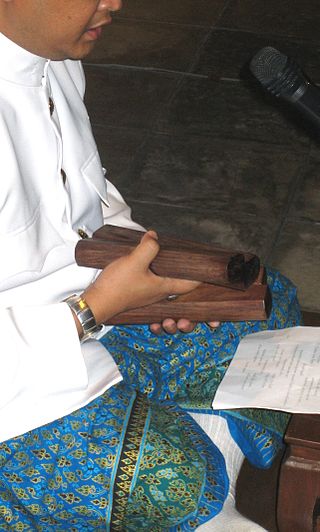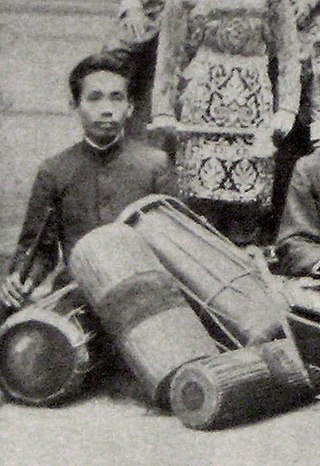
The music of Cambodia is derived from a mesh of cultural traditions dating back to the ancient Khmer Empire, India, China and the original indigenous tribes living in the area before the arrival of Indian and Chinese travelers. With the rapid Westernization of popular music, Cambodian music has incorporated elements from music around the world through globalization.

The goblet drum is a single-head membranophone with a goblet-shaped body. It is most commonly used in the traditional music of Egypt, where it is considered the national symbol of Egyptian Shaabi Music. The instrument is also featured in traditional music from West Asia, North Africa, South Asia, and Eastern Europe. The African djembe is also a goblet membranophone. This article focuses on the Middle Eastern and North African goblet drum.

The samphor is a small, 2-headed barrel drum indigenous to Cambodia, approximately .35 meter wide by .5 meter long. It has two heads, with one drumhead being larger than the other and is played with both hands. Depending on the ability of the musician, the samphor can make as many as 8 different pitches. The player of the sampho leads the pinpeat, setting the tempo and beat. It is also played at freestyle boxing evens, accompanying the sralai. The samphor is analogous to the taphon used in Thailand.

The Pinpeat is the largest Khmer traditional musical ensemble. It has performed the ceremonial music of the royal courts and temples of Cambodia since ancient times. The orchestra consists of approximately nine or ten instruments, mainly wind and percussion. It accompanies court dances, masked plays, shadow plays, and religious ceremonies. This ensemble is originated in Cambodia since before Angkorian era.
Yike is a prominent form of Cambodian musical theater, along with Bassac theater and Niyeai. "Lakhon Yike" incorporates singing and dancing and "an ensemble of both traditional and modern instruments."

Traditional Cambodian musical instruments are the musical instruments used in the traditional and classical music of Cambodia. They comprise a wide range of wind, string, and percussion instruments, used by both the Khmer majority as well as the nation's ethnic minorities.

The thon and rammana are hand drums played as a pair in Thai classical music. It consists of two drums: the thon (โทน), a goblet drum with a ceramic or wooden body and the rammana (รำมะนา), a small rebana-typed frame drum or tambourine. They are used usually in the khruang sai ensemble. The thon gives a low pitch and the rammana gives a high pitch. Earlier in the 20th century, the thon and rammana were sometimes played separately.
Klong that are large barrel drums used in the classical music of Thailand. They are played with large wooden sticks. They are usually played in a pair and used in the piphat ensemble. Drums of this kind have also been called klong chatri (กลองชาตรี) and klong túk (กลองตุ๊ก).

Klong yao, called Khawng yao in Laos, is a long drum used in Thailand and Laos. It is generally slung over the shoulder and played with the hands. It has a wooden body and a drumhead made from water buffalo skin, and is usually decorated with a colorful skirt. It is played in many festival parades in Thailand. Extremely large klong yao, which may be up to 10 m in length, are sometimes encountered in parades, where they are carried by truck.

The Roneat Dek is a Cambodian metallophone, comparable to the Roneat ek. It is an ancient instrument made of 21 blackened-iron bars. It may be used in the Pinpeat ensemble and Mahaori orchestra. It is believed to have originated from the Royal Courts before the Angkor period. This instrument is rarely covered with ornamentation on either the bars or the sound box. The roneat dek is analogous to the ranat ek lek of Thailand.

The krap is a Southeast Asian musical instrument used in Cambodia and Thai for percussion.

Roneat is the generic Khmer word for referring to several types of xylophones used in traditional Cambodian music; the pinpeat and mohaori.

The Skor thom are Cambodian 2-headed barrel drums played with a pair of wooden drumsticks. They typically have skin heads made from oxen, cows or buffalos, and are played in pairs. The drums are tuned such that one will give a "tighter and louder" sound when struck, while the other gives a "loose and more flatter tone." The log is hollowed out to form a thin tube, about 1 centimeter thick, and the hide is stretched out on each side to create the drum. Dimensions for the instruments vary, as they are carved from logs; however they can measure 50 centimetres long and be 46 centimetres in across at the center of the drum, with the ends being about 40 centimetres wide.

The skor daey is a short goblet drum from Cambodia, approximately 40 centimeters tall and 15 centimeters wide at the top. There are two common goblet drums there, the skor chhaiyam, a very long goblet drum, resembling some from Burma, and the skor daey.

The skor chhaiyam is a tall Cambodian goblet drum, slung over the shoulder with a string, so it can be played at waist level while walking. Only the top has skin, leaving a sound-hole at the bottom of a narrowed drum body. The instrument is used to "celebrate happy events."

The skor yike is a family of Cambodian frame drums used in Yike theater. There are as many as 13 different sizes, including the largest, the skor mei. In the Yike drama, the skor mei starts and ends the music.

The skor sang na or sko chhneah is a Cambodian barrel drum, similar in shape to the samphor but smaller, measuring 60 centimeters by 20 centimeters. The instrument is small enough to carry. Like the skor chaiyam which has a strap to allow the instrument to be carried in parades, the skor sang also has a strap. However, rather than cheerful parades, it had a more solemn purpose, playing in funeral processions and ceremonies. Used to play "Khlang Chanack" funeral music.
The lau is a Cambodian flat-faced gong, measuring approximately 25 centimeters across, used in Bassac theater for scenes requiring a loud instrument, such as battle scenes. It is also used to signal the entrance and exit of important characters.

The pin is a Cambodian arched harp, one of the most historically important instruments in Cambodian music. The instrument went extinct c. 1500s, and is now being restored in modern times. Its historical importance is emphasized by the very name for Cambodian classical music, pinpeat. After the pin was no longer being used, Cambodians continued to use the instrument's name for classical music into the present era. When the pin was no longer being used, the tonal range of other instruments was expanded, possibly to compensate. Burmese saung gauk and roneats had more keys for the chromatic scale and the number of gongs in the kong von thom and kong toch "more than doubled in number since the musician depicted on the Angkorian carvings."

Mohaori is one of the traditional musical ensembles of Cambodia. This traditional ensemble is known in full name as Vung Phleng Mohaori (វង់ភ្លេងមហោរី), literally means Mohaori Musical Ensemble. It composed of many kinds of musical instruments, but today it is more specifically applied to a small ensemble of wind, stringed, and percussion musical instruments.
















